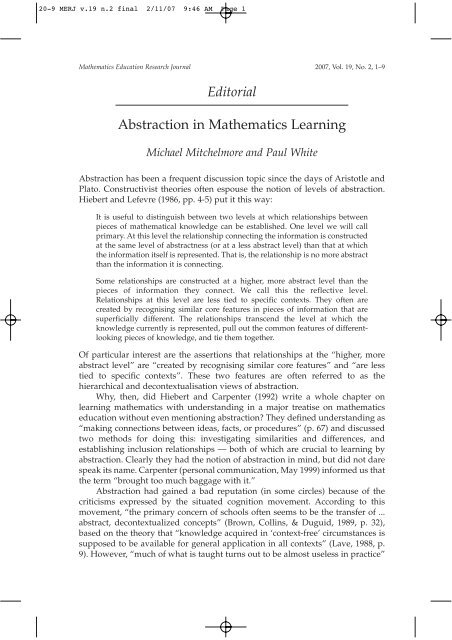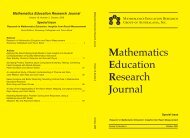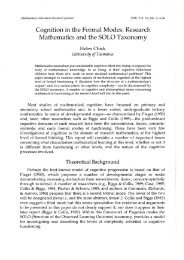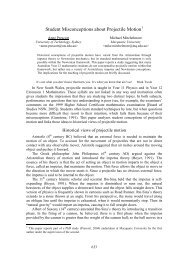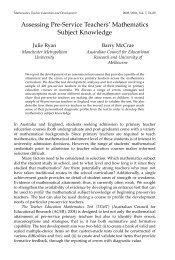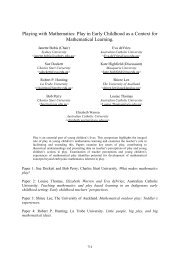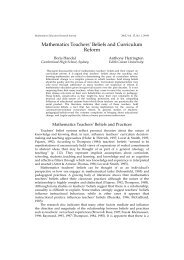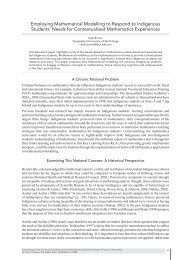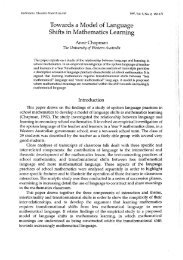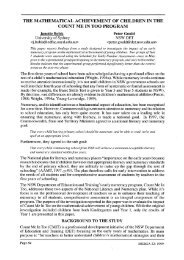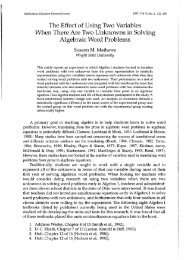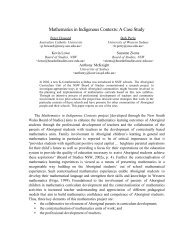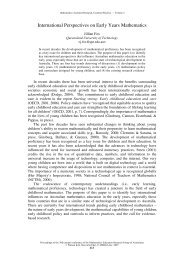Abstraction in Mathematics Learning - merga
Abstraction in Mathematics Learning - merga
Abstraction in Mathematics Learning - merga
Create successful ePaper yourself
Turn your PDF publications into a flip-book with our unique Google optimized e-Paper software.
20-9 MERJ v.19 n.2 f<strong>in</strong>al 2/11/07 9:46 AM Page 1<br />
<strong>Mathematics</strong> Education Research Journal 2007, Vol. 19, No. 2, 1–9<br />
Editorial<br />
<strong>Abstraction</strong> <strong>in</strong> <strong>Mathematics</strong> Learn<strong>in</strong>g<br />
Michael Mitchelmore and Paul White<br />
<strong>Abstraction</strong> has been a frequent discussion topic s<strong>in</strong>ce the days of Aristotle and<br />
Plato. Constructivist theories often espouse the notion of levels of abstraction.<br />
Hiebert and Lefevre (1986, pp. 4-5) put it this way:<br />
It is useful to dist<strong>in</strong>guish between two levels at which relationships between<br />
pieces of mathematical knowledge can be established. One level we will call<br />
primary. At this level the relationship connect<strong>in</strong>g the <strong>in</strong>formation is constructed<br />
at the same level of abstractness (or at a less abstract level) than that at which<br />
the <strong>in</strong>formation itself is represented. That is, the relationship is no more abstract<br />
than the <strong>in</strong>formation it is connect<strong>in</strong>g.<br />
Some relationships are constructed at a higher, more abstract level than the<br />
pieces of <strong>in</strong>formation they connect. We call this the reflective level.<br />
Relationships at this level are less tied to specific contexts. They often are<br />
created by recognis<strong>in</strong>g similar core features <strong>in</strong> pieces of <strong>in</strong>formation that are<br />
superficially different. The relationships transcend the level at which the<br />
knowledge currently is represented, pull out the common features of differentlook<strong>in</strong>g<br />
pieces of knowledge, and tie them together.<br />
Of particular <strong>in</strong>terest are the assertions that relationships at the “higher, more<br />
abstract level” are “created by recognis<strong>in</strong>g similar core features” and “are less<br />
tied to specific contexts”. These two features are often referred to as the<br />
hierarchical and decontextualisation views of abstraction.<br />
Why, then, did Hiebert and Carpenter (1992) write a whole chapter on<br />
learn<strong>in</strong>g mathematics with understand<strong>in</strong>g <strong>in</strong> a major treatise on mathematics<br />
education without even mention<strong>in</strong>g abstraction They def<strong>in</strong>ed understand<strong>in</strong>g as<br />
“mak<strong>in</strong>g connections between ideas, facts, or procedures” (p. 67) and discussed<br />
two methods for do<strong>in</strong>g this: <strong>in</strong>vestigat<strong>in</strong>g similarities and differences, and<br />
establish<strong>in</strong>g <strong>in</strong>clusion relationships — both of which are crucial to learn<strong>in</strong>g by<br />
abstraction. Clearly they had the notion of abstraction <strong>in</strong> m<strong>in</strong>d, but did not dare<br />
speak its name. Carpenter (personal communication, May 1999) <strong>in</strong>formed us that<br />
the term “brought too much baggage with it.”<br />
<strong>Abstraction</strong> had ga<strong>in</strong>ed a bad reputation (<strong>in</strong> some circles) because of the<br />
criticisms expressed by the situated cognition movement. Accord<strong>in</strong>g to this<br />
movement, “the primary concern of schools often seems to be the transfer of ...<br />
abstract, decontextualized concepts” (Brown, Coll<strong>in</strong>s, & Duguid, 1989, p. 32),<br />
based on the theory that “knowledge acquired <strong>in</strong> ‘context-free’ circumstances is<br />
supposed to be available for general application <strong>in</strong> all contexts” (Lave, 1988, p.<br />
9). However, “much of what is taught turns out to be almost useless <strong>in</strong> practice”
20-9 MERJ v.19 n.2 f<strong>in</strong>al 2/11/07 9:46 AM Page 2<br />
2 Mitchelmore & White<br />
(Brown et al., 1989, p. 32), consonant with “the meagre evidence for transfer<br />
garnered from a very substantial body of work [<strong>in</strong> cognitive psychology]” (Lave,<br />
1988, p. 32).<br />
Objections cont<strong>in</strong>ued to be made to the traditional approach to abstraction.<br />
Noss and Hoyles (1996) argued aga<strong>in</strong>st the hierarchical and decontextualisation<br />
views of abstraction. They characterised “abstraction as a process of connection<br />
rather than ascension” (p. 48) and sought to break the word abstract “free from<br />
its dehumanis<strong>in</strong>g connotations” (p. 49). They <strong>in</strong>troduced the idea of a webb<strong>in</strong>g<br />
as “the presence of a structure that learners can draw up and reconstruct for<br />
support — <strong>in</strong> ways that they can choose as appropriate for their struggle to<br />
construct mean<strong>in</strong>g for some mathematics” (p. 108), and <strong>in</strong>troduced the term<br />
situated abstraction to describe “how learners construct mathematical ideas by<br />
draw<strong>in</strong>g on the webb<strong>in</strong>g of a particular sett<strong>in</strong>g which, <strong>in</strong> turn, shapes the way the<br />
ideas are expressed” (p. 122).<br />
Van Oers (1998) also criticised the idea of decontextualisation as the basis for<br />
abstraction, argu<strong>in</strong>g that context is always relative to an <strong>in</strong>dividual so that<br />
decontextualisation suggests removal of the <strong>in</strong>dividual. He has also argued (van<br />
Oers, 2001) that remov<strong>in</strong>g context must impoverish a concept rather than enrich<br />
it.<br />
What these examples show is that the notion of abstraction cannot be<br />
ignored, but is as controversial as ever. Interest <strong>in</strong> learn<strong>in</strong>g by abstraction has<br />
grown <strong>in</strong> the past ten years. The International Journal of Educational Research<br />
published a special issue on “Approaches to abstraction” <strong>in</strong> 1997 and the<br />
Cognitive Science Quarterly followed suit with a special issue on “<strong>Abstraction</strong> <strong>in</strong><br />
context” <strong>in</strong> 2001. A research forum on “<strong>Abstraction</strong>: Theories about the<br />
emergence of knowledge structures” took place at the annual PME conference <strong>in</strong><br />
2002 (Boero et al., 2002), and a symposium on “Reth<strong>in</strong>k<strong>in</strong>g abstraction and<br />
decontextualization <strong>in</strong> relationship to the transfer dilemma” was held at the<br />
Annual Meet<strong>in</strong>g of the American Educational Research Association <strong>in</strong> 2004. The<br />
discussion groups on learn<strong>in</strong>g by abstraction that we organised at the 2005 and<br />
2006 PME conferences eventually led to this special issue of the <strong>Mathematics</strong><br />
Education Research Journal.<br />
Empirical <strong>Abstraction</strong><br />
The foundational work on hierarchical abstraction theory was done by the late<br />
Richard Skemp, partly build<strong>in</strong>g on the earlier work of Zoltan Dienes (1961). The<br />
second edition of his 1971 book The psychology of learn<strong>in</strong>g mathematics, published<br />
<strong>in</strong> 1986, had a strong <strong>in</strong>fluence on our own work but did not have a widespread<br />
impact <strong>in</strong> the face of the situated cognition movement. However, a more recent<br />
resurgence of <strong>in</strong>terest <strong>in</strong> his work is evidenced by a commemorative volume (Tall<br />
& Thomas, 2002) that has chapters contributed from authors <strong>in</strong> the United<br />
K<strong>in</strong>gdom, New Zealand, Australia, United States, Israel, The Netherlands and<br />
Canada. We were honoured to be asked to contribute one of the Australian<br />
chapters.
20-9 MERJ v.19 n.2 f<strong>in</strong>al 2/11/07 9:46 AM Page 3<br />
Editorial 3<br />
Skemp’s conception of abstraction consists of similarity recognition<br />
followed by embodiment of the similarity <strong>in</strong> a new mental object:<br />
Abstract<strong>in</strong>g is an activity by which we become aware of similarities ... among<br />
our experiences. Classify<strong>in</strong>g means collect<strong>in</strong>g together our experiences on the<br />
basis of these similarities. An abstraction is some k<strong>in</strong>d of last<strong>in</strong>g change, the<br />
result of abstract<strong>in</strong>g, which enables us to recognise new experiences as hav<strong>in</strong>g<br />
the similarities of an already formed class. ... To dist<strong>in</strong>guish between abstract<strong>in</strong>g<br />
as an activity and abstraction as its end-product, we shall ... call the latter a<br />
concept. (Skemp, 1986, p. 21; italics <strong>in</strong> orig<strong>in</strong>al)<br />
Skemp’s conception can be called empirical abstraction because it is based on<br />
experience. But it is much deeper than the empirical abstraction described by<br />
Piaget, where the term denotes the extraction of common properties of objects<br />
and extensional generalisations such as colour and weight (Piaget et al., 1977).<br />
The similarity Skemp talks about is not <strong>in</strong> terms of superficial appearances but of<br />
underly<strong>in</strong>g structure. Moreover, similarity recognition is not some random<br />
haphazard identification of th<strong>in</strong>gs which look alike but is usually occasioned by<br />
purposefully directed selective attention. For example, a parent may show a<br />
young child various hands and feet while say<strong>in</strong>g the words hand and foot with<br />
the specific <strong>in</strong>tention of teach<strong>in</strong>g the child these words. In the mathematics<br />
classroom, the direction would usually come from the teacher. Hence, the<br />
embodiment of the similarity (often called reification) is a constructive process<br />
based on generalis<strong>in</strong>g purposefully identified similarities.<br />
Our <strong>in</strong>terest <strong>in</strong> the abstraction process dates back to the early n<strong>in</strong>eties with<br />
a presentation (White & Mitchelmore, 1992) at the annual conference of the<br />
<strong>Mathematics</strong> Education Research Group of Australasia (where, by chance,<br />
Richard Skemp was a keynote speaker). Much of our early work consisted of<br />
apply<strong>in</strong>g Skemp’s theory to the development of young children’s understand<strong>in</strong>g<br />
of the angle concept (Mitchelmore & White, 2000a), but we also <strong>in</strong>vestigated<br />
children’s understand<strong>in</strong>g of rates of change (White & Mitchelmore, 1996) and<br />
decimals (Mitchelmore, 2002).<br />
Because empirical abstraction focuses on the identification of underly<strong>in</strong>g<br />
general features, we call empirical concepts abstract-general (Mitchelmore &<br />
White, 1995; White & Mitchelmore, 2002). Our concern is that students often<br />
learn abstract concepts <strong>in</strong> isolation, without engag<strong>in</strong>g <strong>in</strong> an abstraction process.<br />
Such abstract-apart concepts are poorly understood, easily forgotten, and rarely<br />
applicable — the very characteristics that the situated cognition movement<br />
criticised so strongly. The advantage of empirical abstraction theory is that it<br />
leads to a theory of teach<strong>in</strong>g that could develop deeper understand<strong>in</strong>g. We have<br />
been develop<strong>in</strong>g a theory of what we call Teach<strong>in</strong>g for <strong>Abstraction</strong> (Mitchelmore &<br />
White, 2000b, 2004a), where students:<br />
• familiarise themselves with the structure of a variety of relevant contexts;<br />
• recognise the similarities between these different contexts;<br />
• reify the similarities to form a general concept, and then<br />
• apply the concept <strong>in</strong> new situations.
20-9 MERJ v.19 n.2 f<strong>in</strong>al 2/11/07 9:46 AM Page 4<br />
4 Mitchelmore & White<br />
Investigations of the classroom implementation of this approach <strong>in</strong> the<br />
teach<strong>in</strong>g of percentages (White & Mitchelmore, 2005; White, Wilson, Faragher, &<br />
Mitchelmore, 2007) and ratios and rates (Mitchelmore, White, & McMaster, 2007)<br />
have been promis<strong>in</strong>g, but have revealed many practical implementation problems.<br />
Several of the authors represented <strong>in</strong> this special issue compare their<br />
approach to empirical abstraction but there is no paper which expounds the theory<br />
<strong>in</strong> sufficient detail for the un<strong>in</strong>formed reader to judge the significance of these<br />
comparisons. It is for this reason that we have taken the liberty to discuss empirical<br />
abstraction at length and we trust the reader will forgive us the <strong>in</strong>dulgence.<br />
Theoretical <strong>Abstraction</strong><br />
Often contrasted to empirical abstraction is the idea of theoretical abstraction. Its<br />
genesis owes a great deal to Soviet psychologists, especially Vygotsky and Davydov.<br />
In essence, theoretical abstraction consists of the creation of concepts to fit<br />
<strong>in</strong>to some theory. Davydov (1972/1990) notes that theoretical concepts are<br />
“produced on the basis of a mental and systemic analysis of the relations and<br />
connections among objects” (p. 25) and that, whereas “elementary concepts<br />
basically provide for the identification and classification of objects and<br />
phenomena, theoretical ones additionally permit the explanation of various<br />
manifestations of certa<strong>in</strong> qualities of objects” (p. 27).<br />
Vygotsky (1934/1987) made a correspond<strong>in</strong>g dist<strong>in</strong>ction between everyday<br />
and scientific concepts. Everyday concepts are formed by empirical abstraction,<br />
but the formation of scientific concepts has three features: The establishment of a<br />
system of relations among concepts, an awareness of one’s own mental activity,<br />
and “penetration to the object’s essence ... an enrichment rather than an<br />
impoverish<strong>in</strong>g of the reality presented <strong>in</strong> the concept” (p. 185). “A theoretical<br />
idea or concept should br<strong>in</strong>g together th<strong>in</strong>gs that are dissimilar, different,<br />
multifaceted, and not co<strong>in</strong>cident, and should <strong>in</strong>dicate their proportion <strong>in</strong> the<br />
whole. ... Such a concept, <strong>in</strong> contrast to an empirical one, does not f<strong>in</strong>d someth<strong>in</strong>g<br />
identical <strong>in</strong> every particular object <strong>in</strong> a class, but traces the <strong>in</strong>terconnection of<br />
particular objects with<strong>in</strong> the whole, with<strong>in</strong> the system <strong>in</strong> its formation” (p. 255).<br />
Theoretical abstraction is seen as quite different from empirical abstraction.<br />
“Scientific knowledge is not a simple extension, <strong>in</strong>tensification, and expansion of<br />
people’s everyday experience. It requires the cultivation of particular means of<br />
abstract<strong>in</strong>g, a particular analysis, and generalization, which permits the <strong>in</strong>ternal<br />
connections of th<strong>in</strong>gs, their essence, and particular ways of idealiz<strong>in</strong>g the objects<br />
of cognition to be established” (Davydov, 1972/1990, p. 86). An important phase<br />
of theoretical abstraction is the identification of the essence of an idea. “The<br />
essence of a th<strong>in</strong>g is none other than the basis (<strong>in</strong>cluded <strong>in</strong> itself) for all of the<br />
changes that occur with it <strong>in</strong> <strong>in</strong>teraction with other th<strong>in</strong>gs” (Rub<strong>in</strong>ste<strong>in</strong>, cited by<br />
Davydov, 1972/1990, p. 194). After theoretical abstraction, an object is “mentally<br />
replaced by another — its model” (Davydov, 1972/1990, p. 250).<br />
Some examples could clarify the difference between empirical or theoretical<br />
abstraction. How do children learn the basic geometrical concept of a l<strong>in</strong>e<br />
Accord<strong>in</strong>g to empirical abstraction theory, children recognise an underly<strong>in</strong>g
20-9 MERJ v.19 n.2 f<strong>in</strong>al 2/11/07 9:46 AM Page 5<br />
Editorial 5<br />
similarity between real objects that are only roughly l<strong>in</strong>ear and have been<br />
produced by a variety of means (fold<strong>in</strong>g, pull<strong>in</strong>g, plan<strong>in</strong>g, etc.). Accord<strong>in</strong>g to<br />
theoretical abstraction theory, theoretical ideas of po<strong>in</strong>ts and l<strong>in</strong>es are needed to<br />
express generalisations aris<strong>in</strong>g from spatial <strong>in</strong>vestigations (e.g., two l<strong>in</strong>es meet at<br />
a po<strong>in</strong>t). A second example would contrast learn<strong>in</strong>g by exam<strong>in</strong><strong>in</strong>g several<br />
worked exercises (empirical abstraction) to the deep analysis of one problem <strong>in</strong><br />
order to identify its essential variables and relationships (theoretical abstraction).<br />
There is little conclusive empirical evidence on which to base a judgement as to<br />
which is the more satisfactory explanation or the more effective method of<br />
learn<strong>in</strong>g mathematics, so research goes on.<br />
The most recent example of an attempt to expla<strong>in</strong> theoretical abstraction <strong>in</strong><br />
mathematics learn<strong>in</strong>g is the RBC model (Recognis<strong>in</strong>g, Build<strong>in</strong>g-With,<br />
Construct<strong>in</strong>g) first proposed by Hershkowitz, Schwarz, and Dreyfus (2001).<br />
S<strong>in</strong>ce several of the papers <strong>in</strong> this issue adopt this model as their theoretical<br />
framework, we do not need to describe it here.<br />
In This Issue<br />
There are five articles <strong>in</strong> this edition, with the authors com<strong>in</strong>g from five<br />
countries: United K<strong>in</strong>gdom, Israel, Turkey, Netherlands, and Australia. As such,<br />
the papers represent a variety of theoretical perspectives on the role of<br />
abstraction <strong>in</strong> mathematics learn<strong>in</strong>g.<br />
Van Oers and Poland look at schematis<strong>in</strong>g activities among 5 and 7 year old<br />
Dutch children as they make representational draw<strong>in</strong>gs, show<strong>in</strong>g that they lead<br />
to abstract th<strong>in</strong>k<strong>in</strong>g. The authors argue that “the general is not the end result of<br />
an abstraction process; rather, some general pr<strong>in</strong>ciple is always the beg<strong>in</strong>n<strong>in</strong>g.<br />
An abstract concept then is not so much a reproduction of reality, but actually<br />
establishes a po<strong>in</strong>t of view that guides our th<strong>in</strong>k<strong>in</strong>g.” In other words, an<br />
abstraction does not <strong>in</strong>volve the recognition of a new, previously unnoticed<br />
general characteristic but constitutes an attribute that is added to the object <strong>in</strong><br />
our th<strong>in</strong>k<strong>in</strong>g. This approach appears to cast a shadow on empirical abstraction,<br />
but closer <strong>in</strong>spection shows that there need be no <strong>in</strong>consistency. For it can be<br />
argued that the po<strong>in</strong>t of view students take determ<strong>in</strong>es the underly<strong>in</strong>g<br />
mathematical similarities they look for. Moreover, this po<strong>in</strong>t of view is imposed<br />
by teachers as they propose representational tasks to students.<br />
Gray and Tall cover a spectrum of mathematical topics (whole number,<br />
fractions, algebra, and functions) and a wide variety of countries (England,<br />
Malaysia, Brazil, and Turkey). They describe how mathematical abstraction<br />
arises through a natural mechanism of the human bra<strong>in</strong> <strong>in</strong> which complicated<br />
phenomena are compressed <strong>in</strong>to what they call th<strong>in</strong>kable concepts. Their<br />
framework suggests that, to improve long-term conceptual learn<strong>in</strong>g, the whole<br />
curriculum must be framed <strong>in</strong> such a way as to produce th<strong>in</strong>kable concepts at<br />
every stage. This result can only be achieved if educators are aware of the<br />
abstraction process. The authors give several examples where students acquire<br />
what we have called abstract-apart concepts when educators would prefer they<br />
be abstract-general.
20-9 MERJ v.19 n.2 f<strong>in</strong>al 2/11/07 9:46 AM Page 6<br />
6 Mitchelmore & White<br />
These first two articles, if they do not explicitly espouse the theory of<br />
empirical abstraction as we have outl<strong>in</strong>ed it, are both concerned with describ<strong>in</strong>g<br />
how children learn to <strong>in</strong>terpret their experience. The rema<strong>in</strong><strong>in</strong>g three articles are<br />
more concerned with theoretical abstraction, and they are all based on the RBC<br />
model.<br />
Hershkowitz, Hadas, Dreyfus, and Schwarz <strong>in</strong>vestigate the development of<br />
understand<strong>in</strong>g of probability among groups of Grade 8 students <strong>in</strong> Israel. Us<strong>in</strong>g<br />
an extended RBC+C model (RBC plus Consolidat<strong>in</strong>g), they analyse students’<br />
learn<strong>in</strong>g <strong>in</strong> considerable detail and demonstrate conv<strong>in</strong>c<strong>in</strong>gly that their model<br />
allows the description of theoretical abstraction <strong>in</strong> terms of epistemic actions. The<br />
criticism that they have voiced <strong>in</strong> discussion groups, that empirical abstraction<br />
theory does not provide a similar level of detail, is probably well justified. We are<br />
look<strong>in</strong>g forward to research show<strong>in</strong>g how such a detailed analysis can be used<br />
by mathematics educators to improve student learn<strong>in</strong>g.<br />
Ozmantar and Monaghan take a dialectical materialist approach to<br />
abstraction, follow<strong>in</strong>g Marxist theory, <strong>in</strong> <strong>in</strong>vestigat<strong>in</strong>g the learn<strong>in</strong>g of absolute<br />
value function among Turkish Grade 10 students. This paper is particularly<br />
<strong>in</strong>terest<strong>in</strong>g because it explicitly considers the role of the teacher <strong>in</strong> student<br />
learn<strong>in</strong>g. In com<strong>in</strong>g to grips with the first section of the paper, the reader should<br />
note that “<strong>in</strong> dialectical materialism, it has been agreed to call concrete this<br />
objective <strong>in</strong>tegrity that exists <strong>in</strong> the connection of <strong>in</strong>dividual th<strong>in</strong>gs” (Davydov,<br />
1972/1990, p. 256). So the term “concrete” does not have the same mean<strong>in</strong>g <strong>in</strong><br />
this paper as it usually does elsewhere. The theory is quite right to reject the type<br />
of abstraction which leaves ideas disconnected (abstract-apart), but empirical<br />
abstraction as we have described it would also produce ideas that are connected<br />
both to each other and to the world of experience (abstract-general). Learn<strong>in</strong>g<br />
about absolute value functions cannot <strong>in</strong>volve empirical abstraction because it is<br />
an entirely theoretical construct. In this case, learn<strong>in</strong>g is much better described by<br />
the RBC model of theoretical abstraction.<br />
Williams uses the RBC Model to exam<strong>in</strong>e a phenomenon that all teachers<br />
dream of — spontaneous student learn<strong>in</strong>g. Her data come from <strong>in</strong>terviews with<br />
two Grade 8 students, one from the USA and one from Australia, work<strong>in</strong>g on<br />
l<strong>in</strong>ear functions. Us<strong>in</strong>g ideas first advanced by Krutetskii (1969/76), she pulls<br />
apart their th<strong>in</strong>k<strong>in</strong>g processes and ref<strong>in</strong>es the Build<strong>in</strong>g-With and Construct<strong>in</strong>g<br />
epistemic actions to create a Spontaneous Abstract<strong>in</strong>g Model. Not<strong>in</strong>g that both<br />
case study students demonstrated visible positive affect and achieved a<br />
remarkable depth of understand<strong>in</strong>g <strong>in</strong> such a short time, Williams poses the<br />
fasc<strong>in</strong>at<strong>in</strong>g question of how teachers can promote spontaneous abstract<strong>in</strong>g.<br />
One Theory of <strong>Abstraction</strong><br />
The papers <strong>in</strong> this issue, together with our own exposition of Empirical<br />
<strong>Abstraction</strong> above, represent a variety of theories of abstraction. Is there one<br />
theory which encompasses them all Boero et al. (2002, p. 135) asked “Do we<br />
need one theory of abstraction” We believe it would be useful, but it would be<br />
a theory that takes account of students’ level of mathematical development. We
20-9 MERJ v.19 n.2 f<strong>in</strong>al 2/11/07 9:46 AM Page 7<br />
Editorial 7<br />
would argue that empirical abstraction describes well the <strong>in</strong>itial stage at which<br />
students form fundamental mathematical concepts of number and space, but<br />
that the process of learn<strong>in</strong>g to manipulate symbols (as <strong>in</strong> algebra and calculus)<br />
requires a theoretical abstraction approach such as the RBC+C model (Hassan &<br />
Mitchelmore, 2006). The relation between empirically and theoretically formed<br />
abstractions also needs consideration (Mitchelmore & White, 2004b), and it is<br />
also here that proceptual learn<strong>in</strong>g may occur (Gray & Tall, 1994).<br />
Tall’s (2004) three mathematics worlds may provide the foundation for<br />
build<strong>in</strong>g such a unified theory. We note that his conceptualisation <strong>in</strong>cludes a<br />
formal world of reason<strong>in</strong>g from def<strong>in</strong>itions and axioms, where abstraction may<br />
be very different aga<strong>in</strong> (Dreyfus, 1991). Research on the relation between what<br />
we might provisionally call formal abstraction and theoretical (and even<br />
empirical) abstraction could prove valuable to tertiary mathematics educators.<br />
Acknowledgements<br />
We are <strong>in</strong>deed fortunate that several researchers who have already made<br />
significant contributions to the cont<strong>in</strong>u<strong>in</strong>g debate on the nature of abstraction <strong>in</strong><br />
mathematics learn<strong>in</strong>g are represented <strong>in</strong> this issue. We thank all the authors for<br />
their patience as we have sought to knit the papers <strong>in</strong>to a whole for this issue. We<br />
hope that the result will <strong>in</strong> turn make a contribution that is greater than the sum<br />
of its parts. In particular, we hope that this issue will stimulate research that seeks<br />
to reconcile and comb<strong>in</strong>e the various theories.<br />
References<br />
Boero, P., Dreyfus, T., Gravemeijer, K., Gray, E., Hershkowitz, R., Schwarz, B., Sierp<strong>in</strong>ska,<br />
A., & Tall, D. (2002). <strong>Abstraction</strong>: Theories about the emergence of knowledge<br />
structures. In A. D. Cockburn & E. Nardi (Eds.), Proceed<strong>in</strong>gs of the 26th annual<br />
conference of the International Group for the Psychology of <strong>Mathematics</strong> Education (Vol. 1,<br />
pp. 113-138). Norwich: PME.<br />
Brown, J. S., Coll<strong>in</strong>s, A., & Duguid, P. (1989). Situated cognition and the culture of<br />
learn<strong>in</strong>g. Educational Researcher, 18(1), 32-42.<br />
Davydov, V. V. (1990). Types of generalisation <strong>in</strong> <strong>in</strong>struction: Logical and psychological problems<br />
<strong>in</strong> the structur<strong>in</strong>g of school curricula (Soviet studies <strong>in</strong> mathematics education, Vol. 2; J.<br />
Kilpatrick, Ed., J. Teller, Trans.). Reston, VA: National Council of Teachers of<br />
<strong>Mathematics</strong>. (Orig<strong>in</strong>al work published 1972)<br />
Dienes, Z. P. (1961). On abstraction and generalization. Harvard Educational Review, 31, 281-<br />
301.<br />
Dreyfus, T. (1991). Advanced mathematical th<strong>in</strong>k<strong>in</strong>g processes. In D. O. Tall (Ed.),<br />
Advanced mathematical th<strong>in</strong>k<strong>in</strong>g (pp. 25-41). Dordrecht, The Netherlands: Kluwer.<br />
Gray, E. M., & Tall, D. O. (1994). Duality, ambiguity, and flexibility: A “proceptual” view<br />
of simple arithmetic. Journal for Research <strong>in</strong> <strong>Mathematics</strong> Education, 25, 116-140.<br />
Hassan, I., & Mitchelmore, M. C. (2006). The role of abstraction <strong>in</strong> learn<strong>in</strong>g about rates of<br />
change. In P. Grootenboer, R. Zevenbergen & M. Ch<strong>in</strong>nappan (Eds.), Identities,<br />
cultures and learn<strong>in</strong>g spaces (Proceed<strong>in</strong>gs of the 29th annual conference of the<br />
<strong>Mathematics</strong> Education Research Group of Australasia, Vol. 1, pp. 278-285). Sydney:<br />
MERGA.
20-9 MERJ v.19 n.2 f<strong>in</strong>al 2/11/07 9:46 AM Page 8<br />
8 Mitchelmore & White<br />
Hershkowitz, R., Schwarz, B. B., & Dreyfus, T. (2001). <strong>Abstraction</strong> <strong>in</strong> context: Epistemic<br />
actions. Journal for Research <strong>in</strong> <strong>Mathematics</strong> Education, 32, 195-222.<br />
Hiebert, J., & Carpenter, T. P. (1992). Learn<strong>in</strong>g and teach<strong>in</strong>g with understand<strong>in</strong>g. In D. A.<br />
Grouws (Ed.), Handbook of research on mathematics teach<strong>in</strong>g and learn<strong>in</strong>g (pp. 65-97).<br />
New York: Macmillan.<br />
Hiebert, J., & LeFevre, P. (Eds.). (1986). Conceptual and procedural knowledge <strong>in</strong><br />
mathematics: An <strong>in</strong>troductory analysis. In J. Hiebert, (Ed.). Conceptual and procedural<br />
knowledge: The case of mathematics (pp. 1-27). Hillsdale, NJ: Lawrence Erlbaum.<br />
Krutetskii, V. (1976). Psychology of mathematical abilities <strong>in</strong> schoolchildren (J. Kilpatrick, & I.<br />
Wirzup, Eds., J. Teller, Trans.). Chicago: University of Chicago Press. (Orig<strong>in</strong>al work<br />
published 1968)<br />
Lave, J. (1988). Cognition <strong>in</strong> practice: M<strong>in</strong>d, mathematics and culture <strong>in</strong> everyday life.<br />
Cambridge: Cambridge University Press.<br />
Mitchelmore, M. C. (2002). The role of abstraction and generalisation <strong>in</strong> the development<br />
of mathematical knowledge. In D. Edge & Y. B. Har (Eds.), <strong>Mathematics</strong> education for<br />
a knowledge-based era (Proceed<strong>in</strong>gs of the Second East Asia Regional Conference on<br />
<strong>Mathematics</strong> Education and the N<strong>in</strong>th Southeast Asian Conference on <strong>Mathematics</strong><br />
Education, Vol. 1, pp. 157-167). S<strong>in</strong>gapore: Association of <strong>Mathematics</strong> Educators.<br />
Mitchelmore, M. C., & White, P. (1995). <strong>Abstraction</strong> <strong>in</strong> mathematics: Conflict, resolution<br />
and application. <strong>Mathematics</strong> Education Research Journal, 7(1), 50-68.<br />
Mitchelmore, M. C., & White, P. (2000a). Development of angle concepts by progressive<br />
abstraction and generalisation. Educational Studies <strong>in</strong> <strong>Mathematics</strong>, 41, 209 - 238.<br />
Mitchelmore, M. C., & White, P. (2000b). Teach<strong>in</strong>g for abstraction: Reconstruct<strong>in</strong>g<br />
constructivism. In J. Bana & A. Chapman (Eds.), <strong>Mathematics</strong> education beyond 2000<br />
(Proceed<strong>in</strong>gs of the 23rd annual conference of the <strong>Mathematics</strong> Education Research<br />
Group of Australasia, pp. 432-439). Sydney: MERGA.<br />
Mitchelmore, M. C., & White, P. (2004a). Teach<strong>in</strong>g mathematical concepts: Instruction for<br />
abstraction. Invited regular lecture presented at the 10th International Congress on<br />
Mathematical Education, Copenhagen, Denmark.<br />
Mitchelmore, M., & White, P. (2004b). <strong>Abstraction</strong> <strong>in</strong> mathematics and mathematics<br />
learn<strong>in</strong>g. In M. J. Hø<strong>in</strong>es & A. B. Fuglestad (Eds.), Proceed<strong>in</strong>gs of the 28th Conference of<br />
the International Group for the Psychology of <strong>Mathematics</strong> Education (Vol. 3, pp. 329-336).<br />
Bergen, Norway: PME..<br />
Mitchelmore, M. C., White, P., & McMaster, H. (2007). Teach<strong>in</strong>g ratio and rates for<br />
abstraction. In J. Watson & K. Beswick (Eds.), <strong>Mathematics</strong>: Essential research, essential<br />
practice (Proceed<strong>in</strong>gs of the 30th annual conference of the <strong>Mathematics</strong> Education<br />
Research Group of Australasia, Vol. 2, pp. 503-512).Sydney: MERGA.<br />
Noss, R., & Hoyle, C. (1996). W<strong>in</strong>dows on mathematical mean<strong>in</strong>gs. Dordrecht, The<br />
Netherlands: Kluwer.<br />
Skemp, R. (1986). The psychology of learn<strong>in</strong>g mathematics (2nd ed.). Harmondsworth,<br />
England: Pengu<strong>in</strong>.<br />
Piaget et al. (1977). Recherches sur l’abstraction réfléchissante [Research on reflective<br />
abstraction] (2 vols). Paris: Presses Universitaires de France.<br />
Tall, D. O. (2004). Th<strong>in</strong>k<strong>in</strong>g through three worlds of mathematics. In M. J. Hø<strong>in</strong>es & A. B.<br />
Fuglestad (Eds.), Proceed<strong>in</strong>gs of the 28th Conference of the International Group for the<br />
Psychology of <strong>Mathematics</strong> Education (Vol. 4, pp. 281-288). Bergen, Norway: PME..<br />
Tall, D. O., & Thomas, M. (Eds.). (2002). Intelligence and understand<strong>in</strong>g <strong>in</strong> mathematics.<br />
Flaxton, QLD: Post Pressed.<br />
Van Oers, B. (1998). The fallacy of decontextualization. M<strong>in</strong>d, Culture, and Activity, 5, 135-<br />
142.
20-9 MERJ v.19 n.2 f<strong>in</strong>al 2/11/07 9:46 AM Page 9<br />
Editorial 9<br />
Van Oers, B. (2001). Contextualization for abstraction. Cognitive Science Quarterly, 1, 279-<br />
305.<br />
Vygotsky, L. S. (1987). Th<strong>in</strong>k<strong>in</strong>g and speech. In R. W. Rieber & A. S. Carton (Eds.) & N.<br />
M<strong>in</strong>ick (Trans.), The collected works of L. S. Vygotsky: Vol. 1. Problems of general<br />
psychology (p. 39-285). New York: Plenum. (Orig<strong>in</strong>al work published 1934)<br />
White, P., & Mitchelmore, M. C. (1992). Abstract th<strong>in</strong>k<strong>in</strong>g <strong>in</strong> rates of change and<br />
derivative. In B. Southwell, B. Perry, & K. Owens (Eds.), Space: The first and f<strong>in</strong>al<br />
frontier (Proceed<strong>in</strong>gs of the 15th annual conference of the <strong>Mathematics</strong> Education<br />
Research Group of Australasia, pp. 574-581). Richmond, NSW: MERGA.<br />
White, P., & Mitchelmore, M. C. (1996). Conceptual knowledge <strong>in</strong> <strong>in</strong>troductory calculus.<br />
Journal for Research <strong>in</strong> <strong>Mathematics</strong> Education., 27, 79-95.<br />
White, P., & Mitchelmore, M. C. (2002). Teach<strong>in</strong>g and learn<strong>in</strong>g mathematics by abstraction.<br />
In D. O. Tall & M. Thomas (Eds.), Intelligence and understand<strong>in</strong>g <strong>in</strong> mathematics (pp.<br />
235-256). Flaxton, QLD: Post Pressed.<br />
White, P., & Mitchelmore, M. C. (2005). Teach<strong>in</strong>g percentage as a multiplicative<br />
relationship. In P. Clarkson, A. Downton, D. Gronn, A. McDonough, R. Pierce, & A.<br />
Roche (Eds.), Build<strong>in</strong>g connections: Theory, research and practice (Proceed<strong>in</strong>gs of the<br />
28th annual conference of the <strong>Mathematics</strong> Education Research Group of<br />
Australasia, Melbourne, Vol. 2, pp. 783-790). Sydney: MERGA.<br />
White, P., Wilson, S., Faragher, R., & Mitchelmore, M. C. (2007). Percentages as part whole<br />
relationships. In J. Watson & K. Beswick (Eds.), <strong>Mathematics</strong>: Essential research,<br />
essential practice (Proceed<strong>in</strong>gs of the 30th annual conference of the <strong>Mathematics</strong><br />
Education Research Group of Australasia, Vol. 2, pp. 805-814). Sydney: MERGA.<br />
Guest Editors<br />
Michael C. Mitchelmore, Australian Centre for Educational Studies, Macquarie<br />
University NSW 2109. Email: <br />
Paul White, School of Education (NSW), ACU National, 25A Barker Road,<br />
Strathfield NSW 2135. Email:


